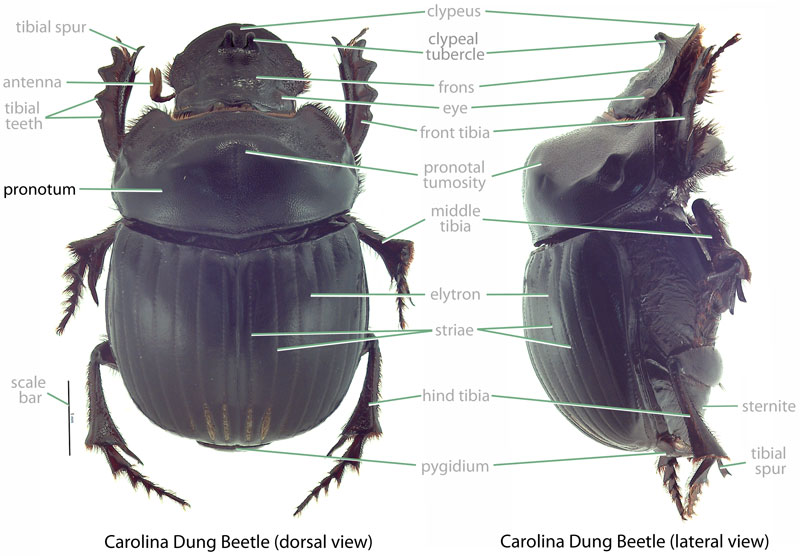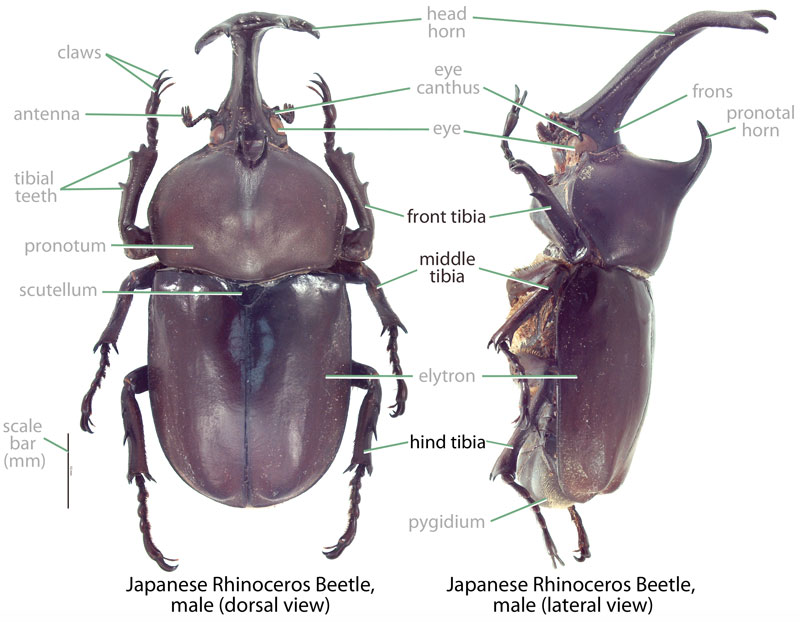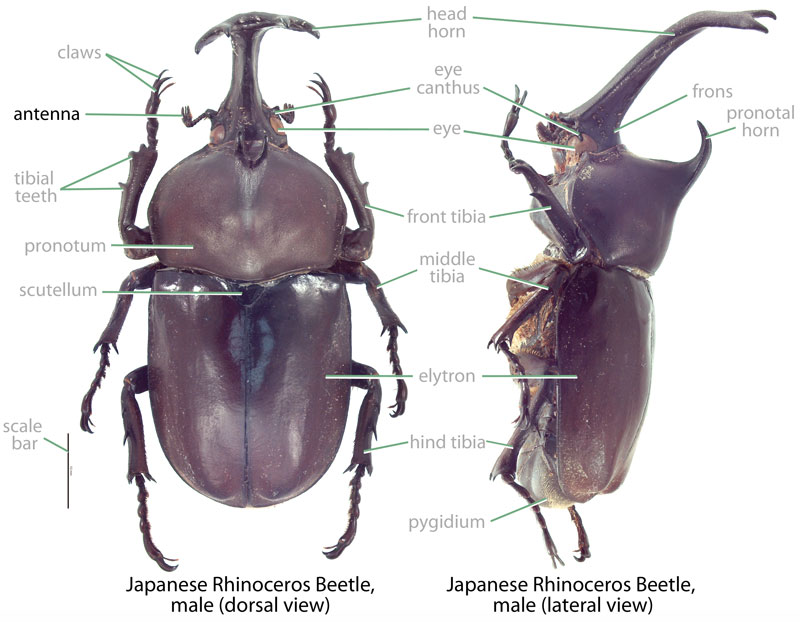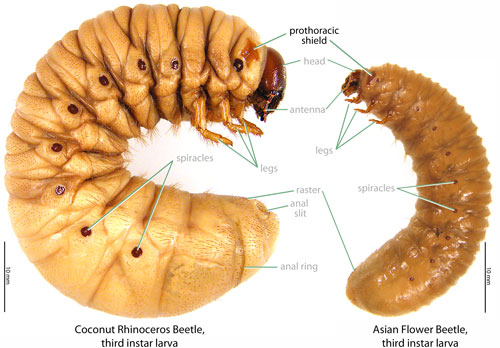Beneficial
yellow shouldered dung beetle
Family: Scarabaeidae Subfamily: Scarabaeinae Genus: Oniticellus Species: Oniticellus militaris (Laporte [Comte de Castelnau], 1840)
none available
Total body length 7.0–11.0 cm (0.27–0.43 in). Body oblong oval, somewhat dorsoventrally compressed; may be caked in dung. Color dark brown; pronotumpronotum:
the dorsal surface of the thorax
 bordered with tan; elytraelytra:
bordered with tan; elytraelytra:
the hardened and chitinous wing-cover of a beetle that protect and overlie the flight wing
with longitudinal tan stripes (some broken). Head of male with short horn, female with distinct transversetransverse:
extending horizontally across a surface
ridge near base. Pronotumpronotum:
the dorsal surface of the thorax
 with weak longitudinal median line; anterioranterior:
with weak longitudinal median line; anterioranterior:
the front or forward; opposite of posterior
margin with excisions pairedpaired:
in relation to bilateral symmetry: occurring on both sides of the body
at middle, excision reduced in female. Front tibiatibia:
a segment of the leg articulated with the tarsus and femur
 of female slightly more robust than in male.
of female slightly more robust than in male.
Undescribed. For Oniticellus spp. (Ritcher, 1966Ritcher, 1966:
Ritcher P. 1966. White grubs and their allies: a study of North American scarabaeoid larvae. Oregon State University Monographs, Studies in Entomology 4: 1-219.): Grub C-shaped, with projecting hump, cylindrical, whitish. Maxillamaxilla:
set of paired mouthparts located posterior to the mandibles
with galeagalea:
outer branch or lobe of the maxilla
 and lacinialacinia:
and lacinialacinia:
inner portion of the maxilla distinctly separated. Epipharynxepipharynx:
distinctly separated. Epipharynxepipharynx:
lobe on the interior surface of the labrum or clypeus
with tormaetormae:
in scarab larvae, sclerotized structures on the ends of the clypeolateral suture extending towards the mesal line
united mesallymesally:
at or near midline of body
, anterioranterior:
the front or forward; opposite of posterior
phoba present. AntennaeAntennae:
paired sensory organ on head, formed from numerous segments
 with 4 segments; distaldistal:
with 4 segments; distaldistal:
situated away from the point of articulation, thus usually furthest from the body
segment of antennaantenna:
paired sensory organ on head, formed from numerous segments
 much reduced in size. Legs 2-segmented. Prothoracic shieldprothoracic shield:
much reduced in size. Legs 2-segmented. Prothoracic shieldprothoracic shield:
the chitinous plate behind the head of larvae
 without anteriorly projecting processes. Third abdominal segment without a prominent, conical, dorsaldorsal:
without anteriorly projecting processes. Third abdominal segment without a prominent, conical, dorsaldorsal:
of or relating to the upper surface; opposite of ventral
gibbosity. Venter of last abdominal segment with 2 patches of short, spine-like setaesetae:
small, hair-like structure
.
Africa. This species is native to eastern Africa, ranging from Ethiopia southward to South Africa. It has been introduced to Australia (Tyndale-Biscoe, 1990Tyndale-Biscoe, 1990:
Tyndale-Biscoe M. 1990. Common dung beetles in pastures of southeastern Australia. CSIRO Publishing, Clayton, Australia.).
None. Oniticellus spp. feed on dung as both adults and larvaelarvae:
the immature form of an insect; in scarabs, also called grub or white grub; preceded by the egg stage, followed by the pupal stage
 .
.
(Tyndale-Biscoe, 1990Tyndale-Biscoe, 1990:
Tyndale-Biscoe M. 1990. Common dung beetles in pastures of southeastern Australia. CSIRO Publishing, Clayton, Australia.): This diurnaldiurnal:
active during daylight hours
species is a dung tunneler, with females constructing a burrow 0–15 cm (0–5.9 in) beneath a dung source. The burrow is stocked with dung to form a brood ball in which one egg is laid. The larvalarva:
the immature form of an insect; in scarabs, also called grub or white grub; preceded by the egg stage, followed by the pupal stage
 develops within its brood ball and will remain within the burrow until emerging as an adult.
develops within its brood ball and will remain within the burrow until emerging as an adult.
None. This species recycles dung and is beneficial for ranching and farming in Hawaii. Being a dung feeder, this species poses no threat to crop or ornamental plants. Additionally, this species is not a threat to native dung beetles because none are known from Hawaii or Guam.
Established. This species was intentionally released in 1957-1958 on Big Island and Oahu (Markin and Yoshioka, 1998Markin and Yoshioka, 1998:
Markin G and Yoshioka E. 1998. Biological control of the horn fly, Haematobia irritans L., in Hawai'i (Diptera: Muscidae). Proceedings of the Hawaiian Entomological Society 33: 43-50. full text (accessed 2015)). It is also found on Kauai and Maui (Nishida, 2002Nishida, 2002:
Nishida G (editor). 2002. Hawaiian terrestrial arthropod checklist, fourth edition. Bishop Museum Technical Report 22: 1-313.), although it is unclear when the beetle arrived to those islands.
Not established or recorded. There are no records of this species from Guam.
In Hawaii, this species was intentionally released.
Oniticellus militaris is one of two Oniticellus species known from Hawaii, the other being Oniticellus cinctus. The two scarabs are separated by examining the head armature (the male of O. militaris possesses a short horn and the female has a distinct transversetransverse:
extending horizontally across a surface
ridge versus O. cinctus that lacks horns or distinct ridges in both sexes), color of the pronotumpronotum:
the dorsal surface of the thorax
 (O. militaris possesses a dark brown pronotumpronotum:
(O. militaris possesses a dark brown pronotumpronotum:
the dorsal surface of the thorax
 bordered in tan, whereas O. cinctushas a shiny black pronotumpronotum:
bordered in tan, whereas O. cinctushas a shiny black pronotumpronotum:
the dorsal surface of the thorax
 ), and pronotal form (O. militaris has anterioranterior:
), and pronotal form (O. militaris has anterioranterior:
the front or forward; opposite of posterior
margin with pairedpaired:
in relation to bilateral symmetry: occurring on both sides of the body
excisions versus O. cinctus with anterioranterior:
the front or forward; opposite of posterior
margin smooth, without excisions).
Liatongus militaris Laporte (Comte de Castelau), Oniticellus quadrituberculatus Lansberge
Report your observation of this beneficial species at our iNaturalist project.